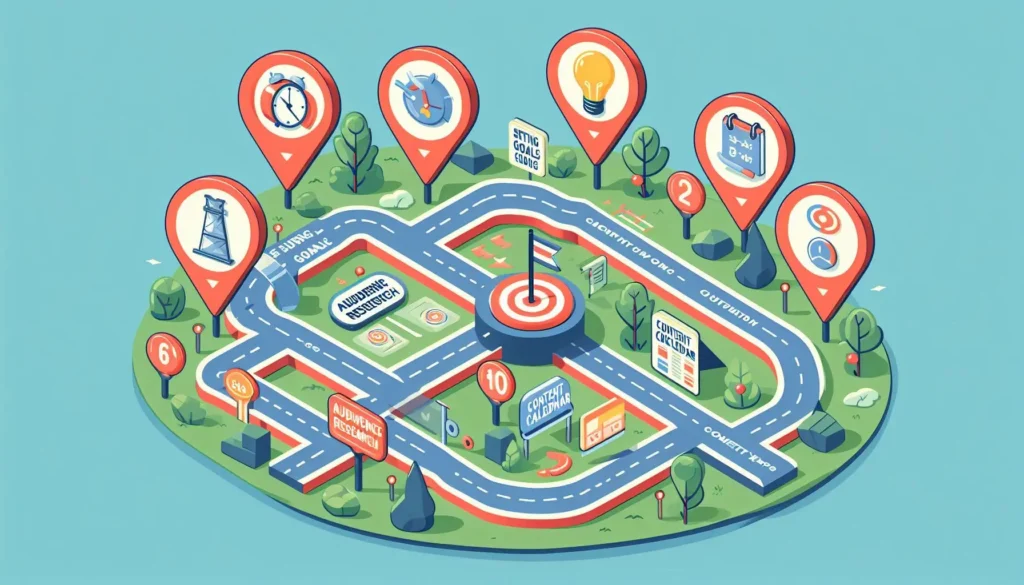Learn What is Digital Content Strategy in Digital Marketing because it is the intricate planning, creating, distributing, and overseeing of content across a multitude of digital platforms with set marketing objectives.
This blueprint encompasses the entire lifespan of content from conception to evaluation heavily focused on provoking desired responses among desired audiences.
Essential Elements of Digital Content Strategy:

Strategic Blueprinting: It begins with setting out specific goals that align with broader marketing visions for digital content strategy.
It involves identifying target audience segments, understanding their needs and preferences, and establishing key performance indicators (KPIs) as measures of success.
Content Generation: Once objectives have been set, the creative process takes off. This entails generating content ideas, sourcing engaging and relevant content in different forms such as articles, visual presentations, and graphical representations, and ensuring that brand messages are consistent.
Content Dissemination: An integral part of digital content strategy is defining how to distribute the content using multiple channels.
Thus, making use of influential social media platforms, emailing campaigns, Search Engine Optimization techniques (SEO), and paid promotions among others will help optimize outreach and engagement with the information provided.
Engagement and Conversion of the Target Audience: A good digital content strategy must go beyond distribution by stimulating audience engagement and creating conversions.
This involves sparking conversations about content through likes, reactions, comments, shares hence leading users towards actions expected such as buying an item online or signing up for a newsletter.
Evaluation and Refinement: Ongoing review and assessment of how content is doing is vital for purposes of gauging its effectiveness.
They can therefore track such metrics as website traffic, engagement metrics, conversion rates, and return on investment (ROI) through the use of analytics tools which are useful in informing data-oriented adjustments that improve strategy with time.
Significance of What is Digital Content Strategy in Digital Marketing:

Increased Brand Visibility and Esteem: A well-designed digital content strategy acts as a conduit for building a brand reputation by providing regular valuable and relevant content to the target audience.
Increased Engagement and Bonding with Customers: It helps businesses to create meaningful interactions that foster trust between them and their customers by understanding what their audience likes or hates.
Boosted Organic Traffic and Conversion Rates: This means providing good search-engine-optimized content, one that not only drives organic traffic but also has high chance of converting visitors into buyers.
Optimized Allocation of Marketing Resources: By having an integrated digital content strategy thus enabling businesses to optimize resource allocation while maximizing returns on marketing investments.
Introduction of Digital Content Strategy in Digital Marketing
The digital marketing arena is characterized by dynamism and competitiveness, requiring a strong digital content strategy for success in the online space.
This article gives a detailed analysis of the various aspects of digital content strategy including its definition, importance, key elements, and effective approaches that can be used to customize it to suit specific business needs in the Internet age.
Chapter 1: Digital Content Strategy Basics
Digital content strategy is the systematic process of creating, sharing, and managing various kinds of content on different digital platforms towards particular marketing goals.
Unlike traditional models, these strategies can be executed through digital media in order to interact with target audiences for desired results.
Main Points:
- Definition: A digital content strategy is basically about preparing the right content for certain marketing intentions within the context of the digital platform.
- Objectives and Benefits: The major goals for any kind of digital content strategy generally include enhancing brand awareness, increasing relevant website traffic, promoting participation, and ultimately transforming leads into returning customers. It also helps establish brand equity as well as accelerate other business development activities.
- Relation to Digital Marketing: An integral component of Internet marketing, the digital content strategy recognizes that the creation and distribution of content are critical for achieving successful marketing outputs in general terms.
Chapter 2: The Importance of Digital Content Strategy

Within the context of today’s competitive digital landscape, having a strong digital content strategy is critical for businesses that want to stand out and succeed consistently.
This chapter explains why investing in a well-planned content strategy is vital to achieve marketing goals and driving business growth.
Main Points:
- Increasing Visibility and Credibility of Brand: Consistently producing high-quality, relevant content helps establish industry authority thereby building trust and credibility among the targeted audience.
- Improving SEO and Online Presence: Adherence to search engine algorithms during content crafting and optimization enhances organic visibility leading to traffic from qualified leads.
- Building Customer Relationships and Trust: Audience-centered contents help in forming strong relations with customers and ensure brand loyalty.
Chapter 3: Characteristics of a Good Digital Content Strategy
For a digital content strategy to work, it must be built upon several interconnected components that complement each other and contribute towards the marketing goals. A holistic approach to this subject is essential for building an overall effective strategy.
Main Points:
- Audience Research and Persona Development: This stage involves a careful analysis of various demographic details, preferences, and problems encountered by the target audience with an aim of creating content that resonates with them and enhances their engagement.
- Content Ideation and Planning: There should be organized brainstorming to generate content topics that match the interests of the audience as well as market trends.
- Content Creation and Optimization: The meticulous creation of top-notch content in different formats such as articles, videos, infographics, etc that would rank high on search engines yet engage users too.
- Content Distribution and Promotion: This encompasses the selective use of various distribution platforms such as social media or email marketing to expand reach or visibility respectively.
- Performance Tracking and Analytics: Content performance metrics e.g. traffic, engagement, and conversions are consistently monitored for strategic fine-tuning or optimization.
Chapter 4: Developing Digital Content Strategy

Core components aside, you need to formulate an action plan and develop a tailored digital content strategy reflecting the various business goals.
Main Points:
- Setting Clear Goals and Objectives: Specific measurable objectives must be put in place if our content strategy is to fit into our larger business goals.
- Conducting Audience Research: drawing on various tools and techniques to extract useful audience insights.
- Creating a Content Calendar and Roadmap: Planning out systematic details over which carry on consistently with a focus.
- Choosing the Right Content Types and Formats: Making strategic choices of relevant forms that connect with the target market while embodying the company’s voice.
- Optimizing Content for SEO and User Experience: Introduce appropriate keywords, and meta-tag optimization for traffic acquisition.
Chapter 5: Implementing and Managing Your Strategy
Execution and management of the digital content strategy require ongoing dedication and optimization to maximize impact and effectiveness.
Main points:
- Content Production and Workflow Management: This entails setting up a smooth content development process, which includes creating, reviewing, and approving it with ease.
- Leveraging Content Distribution Channels: Different kinds of distribution channels, such as social media platforms or email marketing could be employed in order to extend the reach and engagement of the audience.
- Monitoring and Optimizing Content Performance: It calls for the utilization of powerful analytics tools that can track performance indicators for content thus helping to identify trends that can inform data-driven refinements.
- Iterating and Refining the Strategy: This means that strategies must be constantly re-evaluated for their efficacy/ These are necessary because they enable companies to adapt their plans/models when performance insights reveal market dynamics.
Chapter 6: Case Studies and Examples

Real-world case studies and exemplary instances serve as potent illustrations of successful digital content strategies implemented by leading brands across diverse industries.
Main Points:
- Case Studies Highlighting Effective Strategies: Detailed exploration of brands that have executed content strategies with precision to achieve specific marketing objectives.
- Lessons Learned and Key Takeaways: Extraction of actionable insights and best practices from successful case studies to inform and inspire content strategy endeavors.
- Innovative Approaches to Content Creation and Distribution: Exploration of cutting-edge content formats and distribution tactics that have yielded remarkable outcomes.
Chapter 7: Future Trends and Considerations
In the fast-changing digital marketing landscape, acknowledging and adjusting to emerging developments in trends and technologies is vital for maintaining relevance and competitiveness of content strategies.
Main Points:
- AI and Machine Learning: Utilizing AI-powered technologies for personalization of content, chatbot integrations, as well as predictive analytics.
- Video and Interactive Content Trends: Adoption of interactive content formats like videos and live streaming to enhance engagement with audiences.
- Voice Search Optimization: Content optimization to meet the increasing use of voice search and conversational queries.
- User-Generated Content: The use of user-generated content to support authenticity, community involvement and brand advocacy.
Also Read:- Top 11 Advantages and Disadvantages of Online Marketing!
Conclusion
In conclusion, a well-thought-out What is Digital Content Strategy in Digital Marketing is crucial for success in the world of digital marketing.
When businesses use a methodical and data-driven approach to creating and disseminating content, they can leverage the transformational force of digital marketing to interact, communicate effectively, and retain customers with their target groups.
This ultimate guide is designed to provide marketers and entrepreneurs alike with the necessary information, understanding, and means to develop strategic digital content strategies that meet or surpass business targets amidst an ever-changing digital environment.

